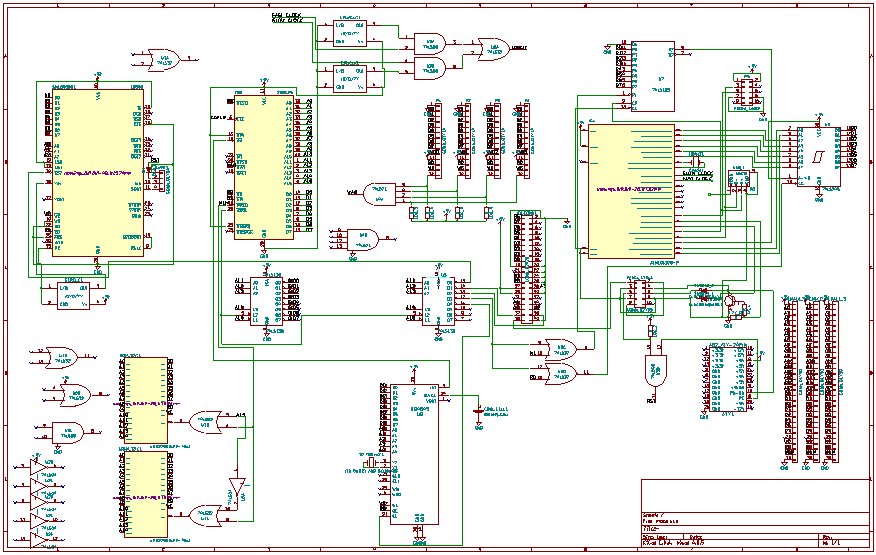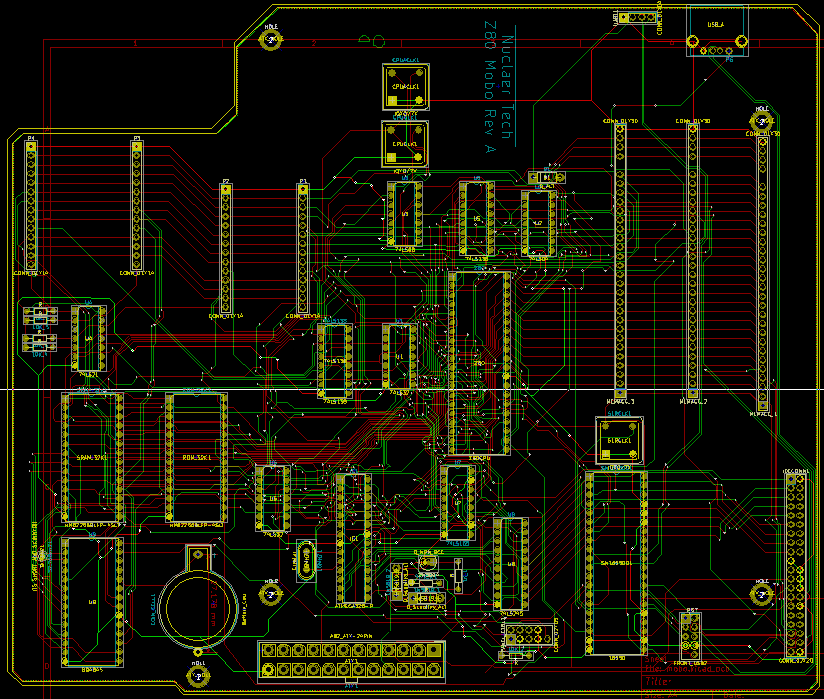-
Designed a motherboard!
06/17/2017 at 21:35 • 0 commentsI spent many hours designing a motherboard in KiCad. It looks like it would work! No, this isn't retro anymore, but I think what I really liked about the Z80 was that it is simple, unlike modern processors, and powerful, unlike most arduinos. It has a DIP pinout, and it is simply the perfect combination of features for me to make a computer with. Since more powerful things are more complicated, and complicated projects can be fun, I realized what I was really aiming for was the most powerful Z80 computer I could build from scratch, then the best OS I could make for it. So it's new features are SUPER COOL (in my opinion).
New Design Features
- 2 Clocks for CPU, one for accessing slow devices and one for faster devices
- RTC with interrupts to allow better multitasking and device polling, and of course timekeeping
- Compatible with ATX power supply
- Standard front panel connector
- UART
- built-in USB to PS2 keyboard converter
- 32KB EEPROM
- 32KB RAM
- IDE connector
I understand that many people who build computers with the Z80 are looking for a retro computer experience, to run old programs OSes or games they remember from the 80's. I didn't ever have that, so I don't really resonate with it. I found out about the Z80 by looking for something more powerful than an Atmel chip, because the computers I was trying to make were too big for it. That was 4 years ago, before I knew what an address bus was. So that is why I think in terms of motherboards, and video cards, and that every computer must have keyboard input and video output.
I also may add more things, like a floppy disk controller. Or any other ideas anyone else has.
Also, its about 335$ for 3 boards from OSH park, so I am going to see if I can do it a bit cheaper: decrease board size - or make a 2-layer PCB with vias underneath chips at home (Yieks!)
Here are some pics of the new board to add to my file uploads:
-
Z80 Motherboard preliminary designs underway
05/27/2017 at 23:43 • 0 commentsPreliminary designs
I basically took my old schematics and made some modifications. NGT20 graphics on the motherboard, EEPROM/RAM switch, support for modern computer power supplies. I guess this isn't 1980s, but rather a 1980s/present hybrid. I will update the project accordingly. I still am adding more things to the design, and I want to add support for RC2014 computer parts (see here). Here is the preliminary schematic:
Expenses
A smaller-than-ATX design I put on OSH Park to see the cost for 3 boards costs about $250.
Cool 3D Printing Idea
I want to make some more money before I do that, plus I just bought a 3d printer and 2kg of filament... Which brings me to an idea I have. What if I could 3d print a pcb? Not like make it in one of the specialized machines, but literally make the board from PLA or ABS filament? And have an alloy that melts at the same temp. as the filament? That will be a project I post in the future. So I might make the motherboard of my Z80 computer in the 3D Printer.
-
Programmer (Finally!)
04/28/2017 at 00:56 • 2 commentsFor a looooong time I have only been able to find absurdly expensive programmers, none at a reasonable price. It SUCKED. Some on ebay were even 1000+ dollars! Ridiculous! Finally I found one for 42$ on ebay here. It came in the mail today and I finally can properly program my Z80 computer.
Why I bought a programmer and didn't build one
I tried programming with my arduino mega. Not only was it tedious and difficult, it hardly ever worked at all. It was a mess. I must have programmed it almost properly once because when I read it with my new TL866CS one of my OSes were there, but in the wrong spot. I think like 32 bytes from the start of the EEPROM, instead of at byte 0.
Is the programmer working well?
Yes! Although it's cheap compared to other programmers it works very well and is easy for me to use. It also programs sooooo many devices. And I got a program to run on my Z80 board!
Problems with my z80 computer
I got a program to run. Barely. I can't remember the address for the debug parallel output, so I just sent 0x55 to every address to debug it. That worked, but I don't know which address that was. The UART wont work (Now that I can test it), and no LED will light up on the peripheral board for my guess at the IDE address. So its pretty much an unusable system (for now). I would like to have an ATX motherboard layout anyways...
Possible solution?
I was coming up with some ideas for a full on Z80 ATX motherboard a few months ago to solve another problem : these boards don't fit in any case! Oh, and an ATX board would allow compatibility with more modern cases, allowing case USB connections and a bit of a surprise to the unsuspecting user. What I was thinking then was how expensive that would be and how much I would never want to pay for making the boards. I discovered Tindie around then, and that's why I wanted to start selling my NGT20: to get into the market so that later I could build my Z80 stuff without loosing money, but rather gaining it. I just don't want to exhaust my bank account, ya know?
So, I really want to make a Z80 ATX motherboard. Without SATA and PCI and DDR-whatever RAM, but just compatible with the case, power supply, and an IDE hard drive/disk drive. If I get a floppy controller I will support floppy drives too.
Anyways, would anyone buy a Z80 ATX motherboard? I know I want one.
-
Finished main expansion board: IDE and UART!
10/28/2016 at 00:19 • 0 commentsI finally finished the expansion board. Its the same size as the main board but is focused on interface with other hardware and peripherals. These include IDE hard/disk drives and UART. The UART is for interfacing with my Open Source Graphics Card and for easier programming of the EEPROM. The graphics card is another project you should check out. I will be testing my new hardware when I make a EEPROM programmer and can really test my programs.
-
Official 3rd Try! Seems like its working this time.
09/11/2016 at 00:57 • 0 commentsWhen I originally started on this project 2 years ago, I made some fairly simple hardware to make a computer with. Although it didn't end up working, I learned a lot and really began to understand how computers worked on a much deeper level. I also got a Z80, along with some other chips I would use in the future. A year later, I tried again. I made a PCB design in EAGLE and ordered my board from OSH park. Since I was inexperienced in the areas I was exploring, I made mistakes in the underlying foundation that the computer would be built upon, eventually leading me to have to scrap that version. Now, I am trying again. This time I know a LOT more about what I am doing, and have made a computer system in an FPGA which taught me too. This version FINALLY seems to be working. I have made an EEPROM programmer, have a working output port, and will be testing the newly-added 32K RAM today. I have also started making OS2, which so far works in the emulator. It, as of now, can read a file, get user input, and dynamically allocate memory. I am trying to make it compatible with CP/M so I can run programs from it.
Z80 overpowered computer
I am building a computer with a 4MHz Z80, 32KiB EEPROM, 32KiB RAM, IDE interface and UART.
 Dylan Brophy
Dylan Brophy

 Expenses
Expenses